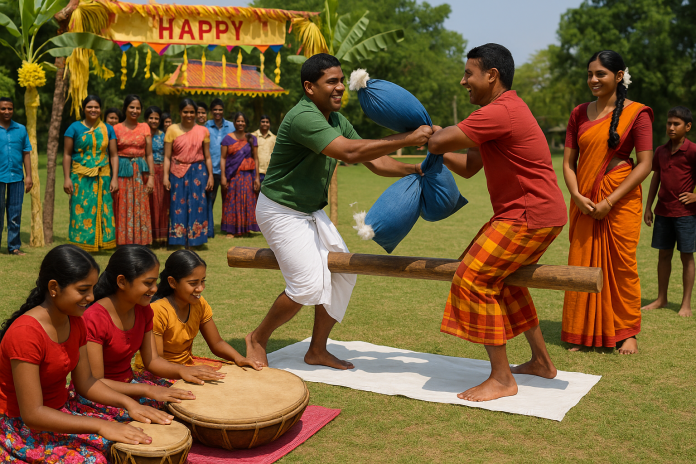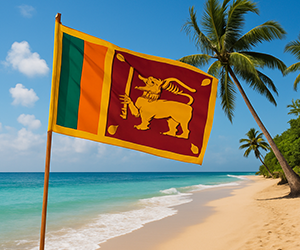Introduction
The Sinhala and Tamil New Year, known locally as Aluth Avurudu (in Sinhala) and Puthandu (in Tamil), is one of the most vibrant and significant cultural festivals celebrated in Sri Lanka. Taking place annually in mid-April, this festival marks the end of the harvest season and the beginning of a new year according to the solar calendar. Unlike the Gregorian New Year on January 1st, this celebration is deeply rooted in astrology, rituals, and traditional practices that span both Sinhala and Tamil communities across the island.
This festival is not just about ushering in a new year; it’s a symbol of ethnic harmony, cultural richness, and Sri Lankan identity. In this article, we explore the history, rituals, foods, games, and spiritual significance of this beloved national celebration.
History and Cultural Significance
Origins of the Sinhala and Tamil New Year
The origins of the Sinhala and Tamil New Year can be traced back to ancient agrarian societies in South Asia. The festival aligns with the sun’s transition from the Meena Rashiya (Pisces) to the Mesha Rashiya (Aries)—a significant astrological movement in both Hindu and Buddhist cosmology.
A Shared Festival Between Sinhalese and Tamils
Despite religious and ethnic differences, both Sinhalese Buddhists and Sri Lankan Tamils (mostly Hindus) observe the New Year with shared customs and similar rituals. This unity through tradition is a cornerstone of the country’s cultural diversity and social cohesion.
Astrological Timings and Rituals
Nonagathe: The Neutral Period
One of the unique features of the Sinhala and Tamil New Year is the Nonagathe or “neutral period”, a time between the old year and the new year during which no work is performed. Instead, families visit temples, engage in religious observances, and reflect spiritually.
Auspicious Times (Nekath)
Everything during the New Year is done at specific auspicious times (nekath), which are determined by astrologers. These times guide important rituals such as:
- Lighting the hearth
- Cooking the first meal
- Starting work or business
- Exchanging money
- Applying oil on the head
Rituals and Traditions
Cleaning and Decorating the House
Before the New Year, families clean their homes thoroughly and decorate with mango leaves, betel leaves, and banana trunks. This signifies purification and welcoming prosperity.
Lighting the Hearth (Lipa Gini Mangalya)
At the auspicious time, the mother of the house lights the fire to prepare the first meal of the New Year. This moment is filled with prayers for prosperity and unity.
First Meal and Kiribath
The first meal usually includes kiribath (milk rice), banana, jaggery, and other sweetmeats. Eating together as a family is considered a blessing and sets a positive tone for the new year.
Anointing with Oil
Elders in the family perform the anointing with herbal oil ritual (Hisa Thel Gema), which is believed to bring good health and protection. This ritual often takes place at temples under the guidance of monks or priests.
Traditional Foods
The New Year table is an explosion of Sri Lankan culinary delights, particularly sweet and fried items that symbolize abundance and celebration. Popular foods include:
- Kiribath – milk rice made with coconut milk
- Kokis – crispy fried sweets made from rice flour and coconut milk
- Kevum (oil cakes) – deep-fried jaggery-sweetened treats
- Aluwa – a sweet made with rice flour, sugar, and cardamom
- Banana, jaggery, and plantains
- Mun kavum, Athirasa, Pani walalu
These dishes not only taste amazing but also carry traditional and symbolic significance passed down through generations.
Traditional Games and Activities
During the New Year, communities come together to enjoy traditional games and sports festivals known as Avurudu Kreeda. These include:
- Kotta pora (pillow fighting)
- Kana mutti bindeema (breaking the clay pot blindfolded)
- Tug of war
- Climbing the greased pole
- Musical chairs and sack races
These games are typically held in village grounds, schools, or community centers, fostering camaraderie and joy among all age groups.
Clothing and Cultural Expressions
During the New Year, many people wear new clothes in auspicious colors, often specified by astrologers. Traditional attire such as the Osariya (Kandyan saree), Indian saree, and Sarong are worn with pride. Cultural expressions like drumming (rabana), singing, and dancing also form a lively part of the celebrations.
Celebrations Across the Island
In Sinhalese Households
Sinhalese Buddhists start the New Year by visiting temples, offering flowers and food to the Buddha, and observing five precepts. The household rituals are completed with blessings from monks.
In Tamil Households
Tamil Hindus typically begin the New Year by visiting Kovils (Hindu temples), where they participate in pujas, oil lamp lighting, and offerings to deities such as Lord Murugan and Lord Ganesha. The Panchangam (astrological almanac) reading is also a common tradition.
Spiritual and Social Importance
The Sinhala and Tamil New Year is more than a cultural event—it is a time of healing, forgiveness, and new beginnings. It reinforces values such as:
- Family unity
- Respect for elders
- Gratitude and sharing
- Ethnic harmony
In a multi-ethnic society like Sri Lanka, this joint celebration offers a rare opportunity for inter-communal bonding, bridging differences through shared heritage.
Sinhala and Tamil New Year in Modern Times
Urban Celebrations
In urban areas like Colombo, Kandy, and Jaffna, the New Year is celebrated with a blend of tradition and modernity. Supermarkets offer Avurudu hampers, radio and TV channels host Avurudu programs, and cities hold public carnivals and parades.
Diaspora Celebrations
Sri Lankan communities abroad—especially in countries like Australia, Canada, UK, and Europe—also observe the Sinhala and Tamil New Year with great enthusiasm. These celebrations help preserve identity and introduce the next generation to their cultural roots.
Travel and Tourism During the New Year
The Sinhala and Tamil New Year is also a peak season for local tourism. Many Sri Lankans travel to their hometowns or go on family vacations to scenic places like Nuwara Eliya, Anuradhapura, or Down South beaches. Tourists visiting Sri Lanka during this period can experience the culture firsthand and participate in village festivals, food fairs, and temple rituals.
Eco-Friendly and Modern Avurudu Trends
In recent years, there has been a shift toward eco-friendly Avurudu celebrations, including:
- Using biodegradable materials for decorations
- Promoting sustainable traditional games
- Reducing firecracker use due to animal welfare and environmental concerns
Additionally, digital greetings, online games, and social media campaigns have made their way into modern Avurudu practices.
Conclusion
The Sinhala and Tamil New Year in Sri Lanka is a glorious celebration of tradition, unity, and renewal. It brings families, communities, and the entire nation together in a spirit of togetherness, respect, and joy. Whether you are a local, a member of the diaspora, or a curious traveler, experiencing Aluth Avurudu or Puthandu offers a deep and joyful insight into the heart of Sri Lankan culture.
As Sri Lanka continues to embrace modernity while honoring its traditions, the Sinhala and Tamil New Year remains a beacon of cultural pride, spiritual fulfillment, and national unity.




